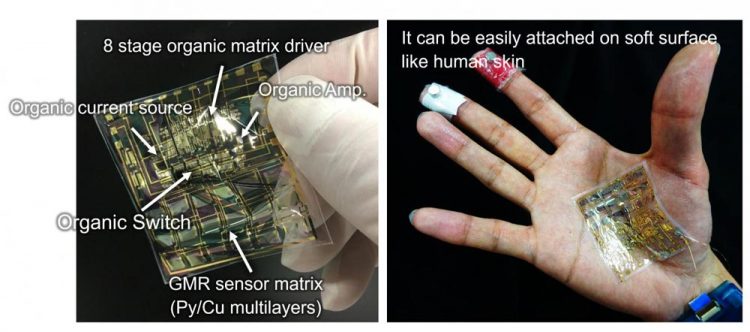Making sense of flexible sensor systems

Imperceptible magnetic sensor matrix system Credit: Osaka University
A team of researchers from Osaka University and Leibniz Institute for Solid State and Materials Research developed the world's thinnest and lightest magnetic sensor matrix sheet system that visualizes the two-dimensional distribution of magnetism on various surfaces.
Conventional magnetic sensor circuits consist of silicon-based hard electronic elements integrated on a substrate with a hardness similar to that of glass, meaning they can be only placed on flat surfaces.
Conversely, flexible soft magnetic sensors have also been developed, but there is no device integrating a driving circuit, sensor scanning mechanism, signal processing circuit, and wireless measurement unit, all of which are required to form a system.
“This is because the fabrication of a flexible magnetic sensor element is difficult. Furthermore, it is hard to integrate the fabrication process with circuit technology,” explains lead author Masaya Kondo.
Now, this joint research team has developed a thin and soft (“skin-like”) magnetic sensor matrix sheet system by integrating flexible electronic elements called organic transistors and giant magnetoresistive elements on a 1.5-μm-thick plastic film. This imperceptible circuit fabricated on a thin plastic film can be attached onto the skin of a person without causing discomfort and can function properly even when folded (Fig. 1).
The magnetic sensor matrix sheet system, with a sensitivity ten times higher than that of conventional systems, not only detects and amplifies weak magnetic signals, but also visualizes the two-dimensional distribution of magnetism in real time by automatically scanning magnetic sensor elements arranged in a matrix pattern (Fig. 2).
Among physical information, magnetic information obtained via a two-dimensional sheet-type magnetic sensor system is much more precise than electrical information because magnetic sensors have high spatial resolution due to the high permeability of magnetism in substances. A sheet-type sensor provides high-precision physical information as it can be adhered to a variety of objects regardless of shape.
“Attaching our sheet-type sensor to a reinforced structure identifies the precise locations of damage by mapping the distortion of magnetism caused by deteriorated reinforcing steel bars. Also, once the sensitivity of the sensor is improved further, higher precision cardiac diagnosis will be achieved by magnetic mapping than by conventional electrocardiography,” says Prof. Sekitani, who led the study.
###
The article, “Imperceptible magnetic sensor matrix system integrated with organic driver and amplifier circuits,” was published in Science Advances at DOI: https:/
About Osaka University
Osaka University was founded in 1931 as one of the seven imperial universities of Japan and now has expanded to one of Japan's leading comprehensive universities. The University has now embarked on open research revolution from a position as Japan's most innovative university and among the most innovative institutions in the world according to Reuters 2015 Top 100 Innovative Universities and the Nature Index Innovation 2017. The university's ability to innovate from the stage of fundamental research through the creation of useful technology with economic impact stems from its broad disciplinary spectrum.
Website: https:/
Media Contact
All latest news from the category: Materials Sciences
Materials management deals with the research, development, manufacturing and processing of raw and industrial materials. Key aspects here are biological and medical issues, which play an increasingly important role in this field.
innovations-report offers in-depth articles related to the development and application of materials and the structure and properties of new materials.
Newest articles

A universal framework for spatial biology
SpatialData is a freely accessible tool to unify and integrate data from different omics technologies accounting for spatial information, which can provide holistic insights into health and disease. Biological processes…

How complex biological processes arise
A $20 million grant from the U.S. National Science Foundation (NSF) will support the establishment and operation of the National Synthesis Center for Emergence in the Molecular and Cellular Sciences (NCEMS) at…

Airborne single-photon lidar system achieves high-resolution 3D imaging
Compact, low-power system opens doors for photon-efficient drone and satellite-based environmental monitoring and mapping. Researchers have developed a compact and lightweight single-photon airborne lidar system that can acquire high-resolution 3D…





















